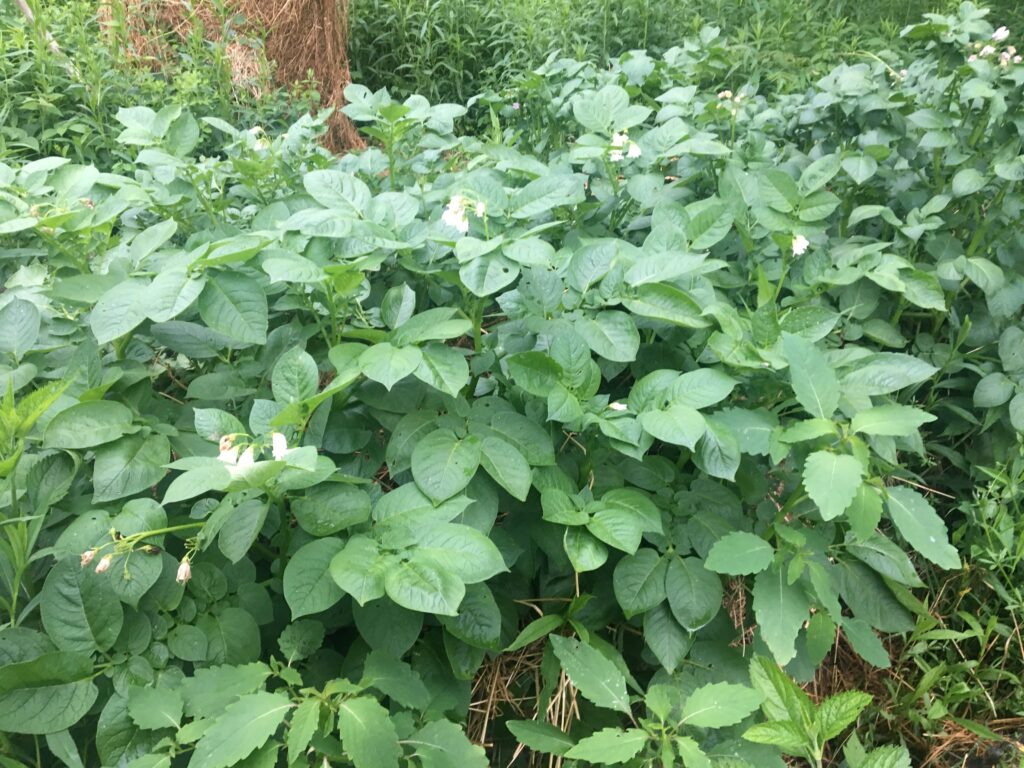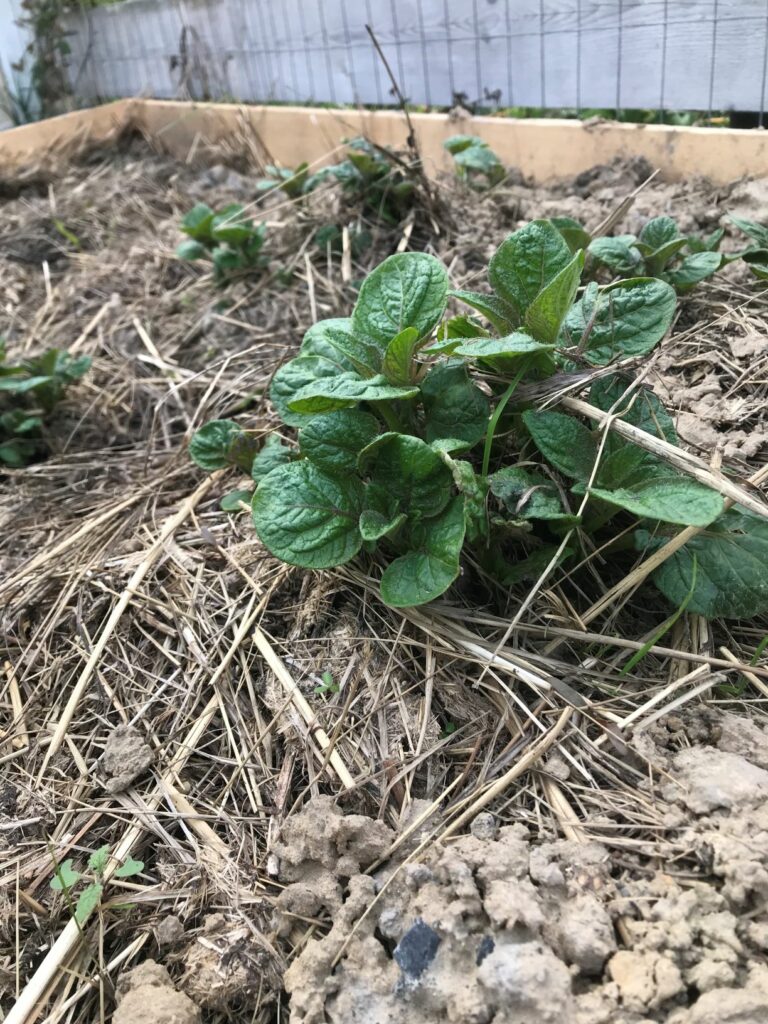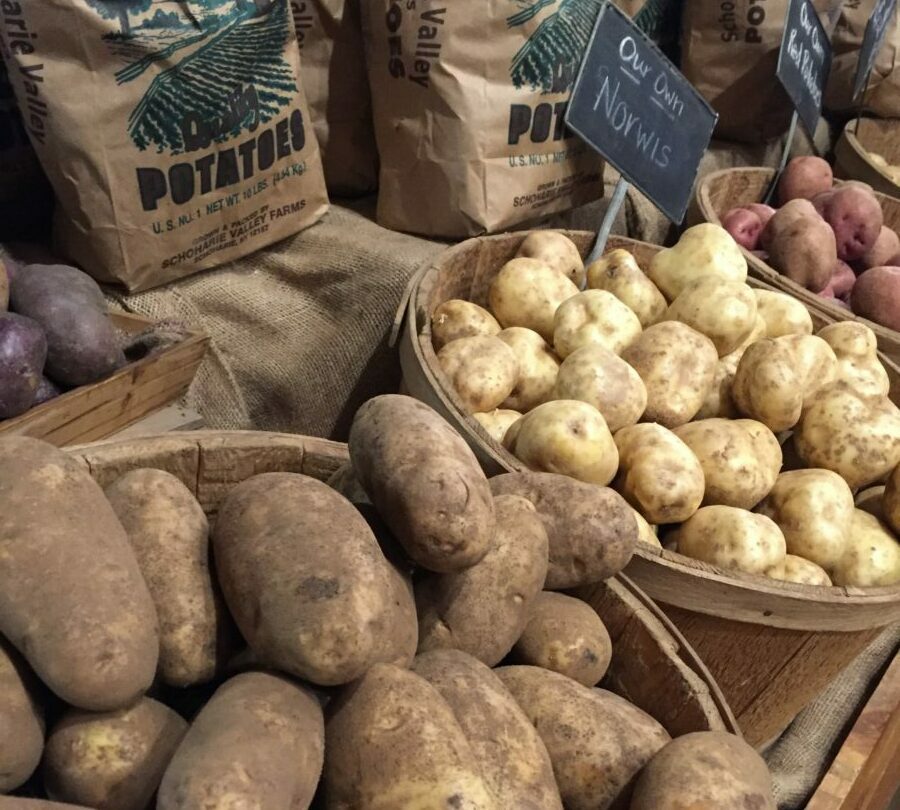Choosing a potato variety to grow in the Home Garden doesn’t need to be a difficult or daunting task.
I don’t think I’ve ever met a potato that I didn’t like.
Boiled, fried, baked, mashed, as a side dish, even as the main course, they all work for me. Potatoes are versatile, easy to cook, and for us, they are a homestead staple. Another great thing about potatoes – they are incredibly easy to grow. With a little bit of space, they’re a great plant for even beginner gardeners to grow.
Potatoes are one of my favorite things to grow on the homestead, they are easy to plant (no tiny seeds!), require little care, aren’t fussy, and they can be a breeze to harvest. Fresh potatoes from the garden have a richer taste and a buttery texture. You can harvest them early on as new potatoes – we love giving them a quick boil and drenching them with butter, garlic, and a heavy sprinkle of salt. If you’d rather have a bumper crop for winter storage you can leave them in the ground and harvest when they are fully grown.

Potatoes were introduced to Europe in the second half of the 16th century by the Spanish and quickly became a food staple. While a staple in Europe, historians believe that the potato got its start in an area of present-day Peru and northwestern Bolivia. Following hundreds of years of selective breeding, there are now over 1000 different types of potatoes in the world. In the US alone there are more than 200 different varieties that are grown and sold.

When you grow your own potatoes, you have access to wide range of cultivators that come in a rainbow of colors, shapes, sizes, and cooking attributes. You’re not limited to mealy generic white, red, or yellow varieties that you find at most grocery stores. No matter if you moon-light a gourmet chef, have long term storage in mind, a hungry family to feed, or just a fan of spuds, I guarantee there’s a potato out there that will suite your needs.
The Potato Plant:
Potatoes belong to the nightshade family and are a relative of the tomato. The vegetative (leaves and stems) and fruiting parts of the potato are toxic, and contain the toxin solanine, these parts of the plant are not fit for human consumption. If the potato tuber is left in the sun, or the plants aren’t properly hilled, and tubers are allowed to grow above ground the skin of the potato will turn green. It’s important to note that green skins on potatoes are also toxic!
Don’t worry, it’s easy to grow potatoes, properly grown and stored potatoes pose no risk to you or your family.
Potato plants are perennials that are grown as annuals. They have weak stems and grow approximately 24 inches high (above ground), and depending on the variety bear white, pink, red, blue, or purple flowers. After flowering, potato plants will produce small green fruits that look similar to a green, unripe cherry tomato. Even though the fruit from a potato plant looks like a tomato, and they are related to tomatoes, don’t eat the fruit, it’s toxic for humans to ingest! Each of those tomatoey looking fruits will produce close to 300 seeds. While not common, or the preferred method of propagation you can grow potatoes from seed, in fact this is how new varieties are discovered.

Even though potatoes can produce seeds, potatoes are usually grown by planting tubers. Potato tubers are also referred to seed potatoes, even though no seeds are involved! When you grow potatoes from seed, you’ll end up with a wide range of plants that have unpredictable characteristics. You could end up with a great plant, or a dud! Potatoes grown from tubers aka seed potatoes result in clones of the parents. We grow our potatoes from tubers, it’s reliable and we know the approximate, size, shape, yields, flavor profile, and what the storage capabilities will be.
If you have space and like to experiment or have a keen interest in genetics try your hand a growing potatoes from seed. It could be a fun and exciting experiment.
Varieties:
Potatoes are generally categorized into a few main groups that are based on some common characteristics; russet potatoes with their rough brown skin, red potatoes, white potatoes, yellow potatoes (sometime referred to as Yukon potatoes), fingerling, and purple/blue potatoes.
For the home cook and chef, varieties are often differentiated by being waxy or floury, and then we also have new potatoes.
- Waxy potatoes – they are creamy and have a firm
texture when cooked. They have a lower
starch content (typically 16 – 18%) and a high-water content. Waxy potatoes will keep their shape when
cooked, and are ideal for boiling, steaming, and roasting.
- If you want your potato to hold up in soups or stews, this is the variety that you want to use
- Floury potatoes – They have a drier and fluffy
texture when cooked. They have a lower
water content and have a higher starch content (typically 20 – 22%). They are great for baking, mashing, and
frying.
- If you want a great baked potato, or some awesome home fries, this is the variety that you want to use
- New Potatoes – these are any type of potato that
is harvested before reaching full size.
They are a great treat from the garden, have a delicate texture, and
thin skins. These potatoes are harvested
when the leaves on the plant are still green – most potatoes are harvested
after the leaves on the plant have turned yellow or brown.
- New potatoes are never kept in storage because of their high sugar content.
If you want to bake, fry, or mash, pick a high starch variety. If you want to boil, roast, grill, sauté, use in a soup or stew, use in salads, or au gratin dish, pick a low starch variety.

Potato Varieties:
- Russet Potatoes – Medium to large sized potatoes
that are oblong or slightly flattened and oval.
They have a floury, dry, light, and fluffy texture, with a hearty
flavorful skin. They are mild and
earthy. This is a great choice for those that want a superb baking or frying
potato, crispy on the outside and fluffy on the inside. They are low in moisture and high in starch. They are also great for making light and fluffy
mashed potatoes.
- Popular varieties: Burbank, Norkotah, Ranger, or Butte. We grow Norkotah in our home garden.
- Yellow potatoes – Extra small to large sized
potatoes that are round or oblong in shape.
They have a tan to golden skin with yellow to golden colored flesh. They are slightly waxy, with a moist and
velvety texture. They are ever so
slightly sweet, rich, creamy, and buttery tasting. They are low to medium in starch, and hold up
well to grilling, roasting, baking, or mashing.
We love to boil small yellow potatoes,
drain them, and smash them into flat disks then gently fry them in extra virgin
olive oil with a dash of salt. We call
them “smashed” potatoes, they are easy to make and delicious!
- Popular varieties: Yukon Gold, Yellow Finn, Agata, Santina. We grow Yukon Gold in our home garden.
- Red
Potatoes – Small to medium sized potatoes that are round or slightly oblong in
shape. They have a smooth, thin red
skin, and white flesh. They are waxy,
moist, smooth, and have a creamy texture.
Like yellow potatoes they are slightly sweet and creamy, in fact they
are typically sweeter than whites. They
are low in starch and have a waxy texture, that means the red potato will stay
firm throughout the cooking process.
They are an excellent choice for salads and soups, diced and roasted, or
mashed. This potato will hold up and a
soup or stew, whereas other varieties can end up disintegrating.
- Popular Varieties: Red Norland, Chieftan, Pontiac, Ruby. We typically grow Norland, or Pontiac (depending on what our local feed and seed store carries that year).
- White Potatoes – Small to medium sized potatoes
that are round or long shaped. They have
white or tan skin and white flesh. They
are slightly creamy, dense, have a medium starch content, and a thin, delicate
skin. They are moist with a low to
medium starch, these potatoes hold their shape well after cooking, and the thin
skins mean they are great in mashed potatoes.
They are great on the grill, and excellent in the fry pan.
- Popular Varieties: Cascade, Kennebec, White Rose, Superior. We usually grow Cascade in our home garden.
- Purple/Blue Potatoes – small to medium sized
potatoes in a variety of shapes, ranging from round, to oblong, to
fingerling. They have a purple or blue
skin, and depending on the variety blue, purple, lavender, pink, red, or white
flesh. The flavor is earthy and nutty,
and they have a low sugar content. These
potatoes are eye catching and a crowd pleaser.
They add a distinct and nutty flavor to your dishes or salads and bring
a pop or color.
- Popular Varieties: Adirondack Blue, Purple Peruvian, Purple Majesty. This year we’re growing Adirondack Blue in our garden.
- Fingerling Potatoes – 2 to 4 inches long that
are finger shaped or oblong. They come
in a variety of colors, red, white, purple/blue, yellow, with a variety of
flesh colors. They have a firm, waxy
texture, with a buttery, nutty, and earthy flavor. They are fun and unique, and great
pan-frying, or roasting in the oven.
Even though these potatoes are small, and may look like new potatoes,
they are fully grown and have a complex flavor.
- Popular Varieties: French Fingerling, Purple Peruvian, and Ruby Crescent
Now that we covered floury vs. waxy potatoes, and discussed different potato varieties, there’s another piece to add to the equation; Late, Mid, and Early Season potatoes. Your garden zone and food goals can help you determine if a Late, Mid, or Early Season potato is the way to go for you.
Potatoes are cool season vegetables that are able to tolerant light frost in the early spring, and able to grow during cooler part of the fall season.
- Early Season Potatoes: These potato varieties reach maturity in 75 –
90 days. These are great to grow if you
want new potatoes or a crop early in the season. Early season potatoes will be ready to
harvest in the summer, just in time for BBQs.
- Popular Varieties: Norland (a red-skinned potato that’s resistant to scab), Butte (a high yield of russet skinned spuds that are great for baking and making potato pancakes)
- Mid-Season Potatoes: These potato varieties
reach maturity in 95 – 110 days. They
mature and will be ready to harvest in the fall.
- Popular Varieties: French Fingerling, Red Pontiac, Yukon Gold (a large yellow skinned potato)
- Late Season Potatoes: These potato varieties
reach maturity in 120 – 135 days. These
potatoes take longer to grow, but they typically produce a heavy crop that will
keep well in storage. If you have a long
enough growing season and what a crop that will keep through the winter look
into growing some late varieities.
- Popular Varieties: Katahdin ( a light brown skinned variety which is resistant to some viruses), Kennebec, Norkotah
When choosing what varieties to plant, think about how you and your family most often prepare and eat potatoes. Do baked potatoes dominate as your choice for sides? Are you a mashed potato family, with skins or without? Fried potatoes on Sunday morning, homemade fries, and chips, summer salads, picky eaters that like fun pops or color? Or all of the above? There’s really no right or wrong answer when you go to pick a variety, it comes down to personal preference, growing conditions, and storage needs.
If you’re looking to grow and extend your potato harvest over the whole season, consider growing an early, mid, and late season variety. You’ll be able to harvest your spuds starting with new potatoes. If you’re looking for a larger bumper crop that will hold up well to storage, consider planting more late season varieties.

What do we grow in our Garden?
We tend to eat a lot of diced and roasted red potatoes, especially in the winter when we tend to do a lot of roasting and braising in the oven. Another standout favorite in our house is making “smashed potatoes” with small white potatoes.
I also like to plant and grow early, mid, and late season varieties – that way we have several months of fresh potatoes over the growing season, and enough left for winter storage.


Potatoes are a relative of the tomato? Very interesting! I love fingerling and those pretty purple taters! ?